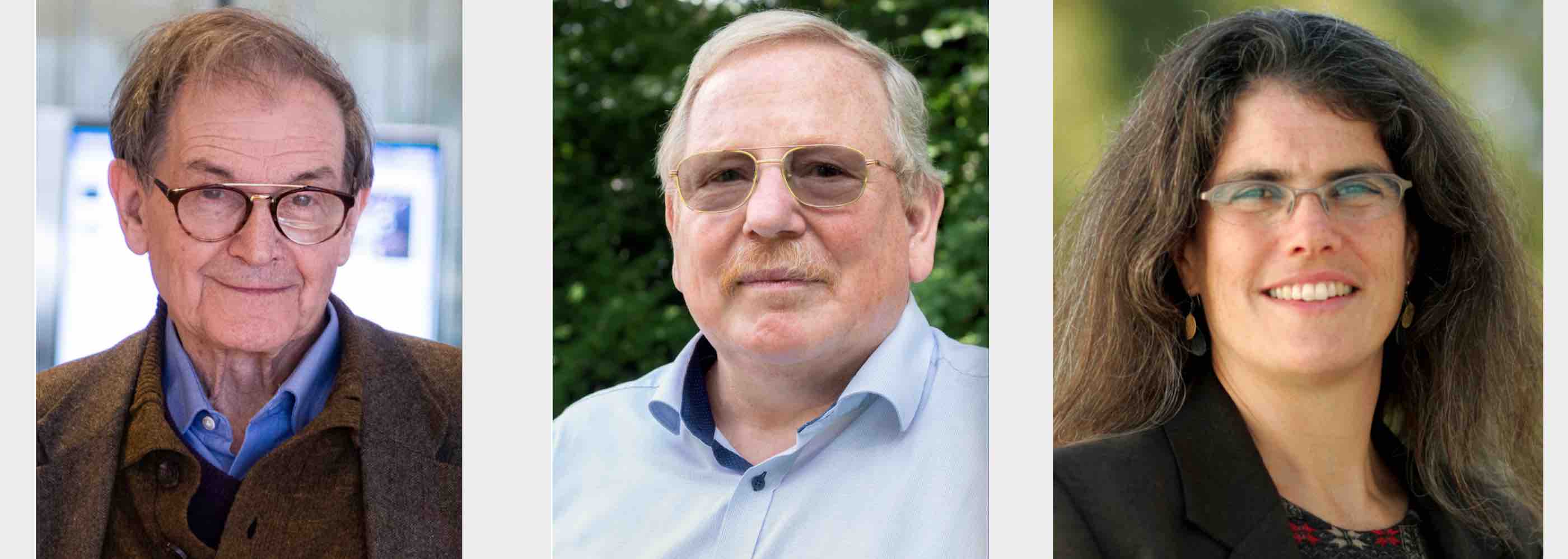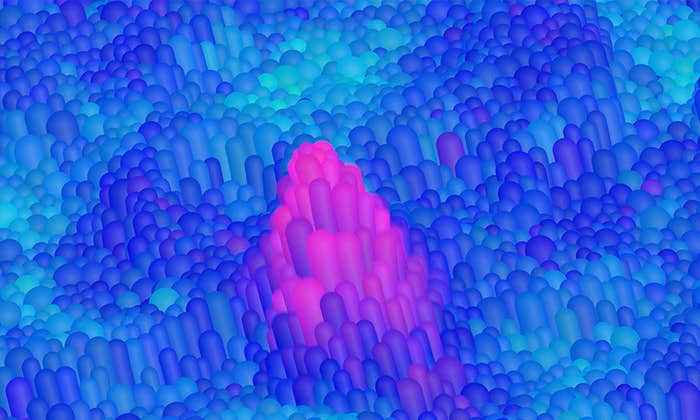Black holes have recently come into the light. In 2019, a global network of telescopes glimpsed the silhouette of a supermassive black hole at the center of a neighboring galaxy. Gravitational wave detectors now regularly sense the tremors of invisible, faraway black hole collisions.
2020’s Nobel Prize in Physics has been awarded for earlier work that indirectly established the existence of black holes. The English mathematical physicist Roger Penrose won half the prize for his 1965 paper showing that “black hole formation is a robust prediction of the general theory of relativity,” according to the Nobel committee. The other half was shared by rival astrophysicists Reinhard Genzel and Andrea Ghez, who made groundbreaking observations of stars orbiting the Milky Way’s center that suggested that a supermassive, invisible, compact object must reside there.
“The first thing is doubt,” Ghez said in October 2020 when asked what went through her mind when she made the crucial observations in the early 2000s that revealed the presence of a black hole at the center of the Milky Way. “Both doubt and excitement. That feeling of being at the frontier of research where you have to always question what you’re seeing.”
Two decades later, there can be no more doubt about black holes and their critical role in the cosmos.
What are black holes?
Black holes are regions that contain so much matter packed within so little space that gravity has a runaway effect: The matter collapses toward a central point of immense density, called a singularity. Everything within a certain distance of the singularity becomes gravitationally trapped, destined to fall inward. Even light that passes inside the black hole’s spherical surface of no return, called the event horizon, gets sucked in, which makes black holes invisible.

A common way to visualize a black hole is as a two-dimensional sheet stretched into a funnel. Go too far down, and you’ll find yourself unable to climb back out. Try to picture the funnel in three dimensions, though, where material falls inward from every direction toward a central point.
In some ways, black holes are incredibly simple. They’re said to have “no hair,” meaning all distinctive features seem to wash away when they form. Each one can be characterized by only its mass, electric charge and angular momentum—making them rather like elementary particles.
But although they look simple from the outside, black holes are deeply mysterious on the inside. Albert Einstein’s general theory of relativity predicts that the curvature of space-time becomes infinite in a black hole singularity, but this isn’t physically possible. These objects show that the theory must be incomplete. Physicists think that they’ll have to come up with a quantum theory of gravity to understand black hole singularities.
How do black holes form?
Black holes form when matter or energy is packed together densely enough. Just how densely? To form a black hole, Earth would have to shrink into a sphere smaller than a pingpong ball.

Although such tiny black holes might have formed during the Big Bang (these are hypothetical entities known as “primordial black holes,” which might comprise the universe’s missing dark matter), the ones observed in the universe today are larger. They typically form when stars at least 10 times more massive than the sun run out of fuel. With outward radiation pressure no longer able to counteract the inward lurch of gravity, the star’s core inwardly collapses—an event usually accompanied by a dramatic explosion called a supernova.
Less certainty surrounds the formation of supermassive black holes, like the 4-million-solar-mass black hole named Sagittarius A* [pronounced A-star] that Reinhard Genzel, Andrea Ghez and their teams studied in the center of the Milky Way. These behemoths probably formed within the universe’s first billion years, as galaxies took shape around them. But whether they started as stars that gravitationally collapsed into black holes and then grew astronomically, or formed from the direct collapse of huge pockets of plasma—or in some other way—remains an open question. In the coming years, the James Webb Space Telescope’s observations of very distant and very young galaxies could solve the puzzle.
What did Roger Penrose figure out about black holes?
Roger Penrose made his key contribution in 1965, not long after the discovery of superluminous objects called quasars. These objects were so bright that researchers hypothesized that they might be the gleam of material falling into ultra-compact, supermassive objects. This renewed interest in the decades-old question of whether black holes were just a mathematical artifact of Einstein’s theory, or if they actually form in the universe.
Penrose showed that they can. In fact, he showed that they inevitably do.
Up until then, researchers had tied themselves in knots trying to figure out whether objects like the “Schwarzschild solution” of Einstein’s equations—the simplest kind of black hole, worked out on paper by Karl Schwarzschild in 1916—were really possible in nature. Such theoretical solutions had only been studied under the simplifying assumption that the material doing the gravitational collapsing is a perfect sphere. The question was whether the resulting singularity was simply an artifact of that perfect spherical symmetry—something possible on paper, but preposterous in nature.

Penrose showed that, as he put it in his 1965 paper, “deviations from spherical symmetry cannot prevent space-time singularities from arising.” In other words, even when a star is distorted, it will still collapse down to a point. He showed this by introducing the notion of a “trapped surface,” as well as a now-famous diagrammatic scheme for analyzing how the surface sits inside space-time. Unlike a regular surface, which can have light rays shooting away from it in any direction, a trapped surface is a closed two-dimensional surface that—even when distorted so it’s no longer a sphere—only allows light rays to go one way: toward the center point.
Penrose found that the dimensions of space and time switch roles inside a trapped surface. Time is the direction pointing toward the center, so that escaping a black hole is as impossible as going back in time. Penrose, together with Stephen Hawking, soon showed that a similar analysis applies to the entire universe: A singularity would have inevitably existed when matter and energy were densely packed together in the Big Bang.
How do we observe black holes?
We detect their invisible presence in several ways. Gravitational wave detectors sense black hole collisions by measuring the resulting stretching and squeezing of space-time. The Event Horizon Telescope uses a global network of telescopes to view, at astonishingly high resolution, the bright ring of light just outside a supermassive black hole’s event horizon. But such direct observations have only happened in the late 2010s.
Starting in the 1960s, astronomers began observing the enormous amount of energy released by the distant objects called quasars. The researchers suspected that quasars were actually supermassive black holes that were pulling in huge amounts of gas and dust. Around the same time, telescopes detected X-rays coming from stars that shouldn’t have been able to produce the radiation on their own. The researchers ultimately concluded that invisible companion black holes must be sucking away the stars’ matter and generating the light.
As for the black hole at the center of our own Milky Way, the first hint of its presence was detected in 1931, when the pioneering radio astronomer Karl Jansky observed a radio signal coming from the direction of the constellation Sagittarius. Then in 1974, the radio astronomers Bruce Balick and Robert Brown pinpointed the bright and compact object in the galactic center that became known as Sagittarius A*. Further observations in the 1990s built more evidence for the presence of super heavy objects in galactic centers, but better technology and clever new observing strategies were needed before astronomers could definitively show that these central anchors were supermassive black holes.
How did Genzel and Ghez prove that Sagittarius A* is a supermassive black hole?
They tracked the motions of stars that swing very close by. If Sagittarius A* was an extended cluster of material, then stars passing through would be pulled on from multiple directions, and their resulting orbits would be unremarkable. But if it was a compact supermassive black hole, then the stars should whip by at high speeds.
Telescopes lacked the spatial resolution necessary to track these orbits precisely enough until Ghez and Genzel came along in the 1990s. Both of their teams pioneered approaches to remove the blur of Earth’s atmosphere. The first technique—called speckle imaging—involved combining multiple brief exposures, each short enough to avoid extended atmospheric distortion. Then a more advanced approach called adaptive optics allowed even finer-grained observations. In adaptive optics, a laser is beamed into the night sky, creating an “artificial star” that is simultaneously imaged by the telescope. (Ghez’s group used the Keck Observatory in Hawai‘i and Genzel’s worked with the Very Large Telescope in Chile.) The artificial star reveals exactly how the atmosphere is distorting the image. An algorithm figures out how to counteract those effects, and small actuators then deform the shape of the telescope’s mirror to remove the distortions in real time.
Both teams homed in on a particular star called S2, whose orbit passed within a galactic stone’s throw of Sagittarius A*. In the early 2000s, S2’s trajectory, along with those of several other close-in stars, indicated that Sagittarius A* measures less than 125 times the distance between Earth and the sun, even though it contains 4 million solar masses. It could only be a supermassive black hole.
Harvey Alter, Michael Houghton and Charles Rice won the Nobel Prize in Physiology or Medicine, and Emmanuelle Charpentier and Jennifer Doudna shared the Nobel Prize in Chemistry.
Video: Animation of Objects. Reinhard Genzel and Andrea Ghez independently tracked the activity around the supermassive black hole at the Milky Way’s center over a period of decades. ESO/MPE/M. Schartmann/L. Calçada
Video: Andrea Ghez. In this 2017 interview, the UCLA astrophysicist Andrea Ghez explains how tracking the movement of stars revealed the existence of a supermassive black hole at the center of the Milky Way galaxy. Video by John Hook for Quanta Magazine.





























